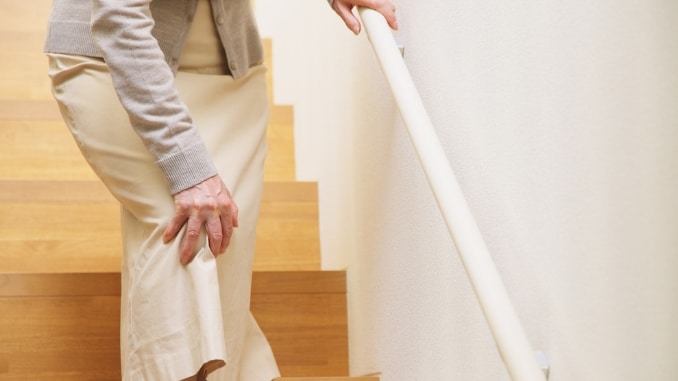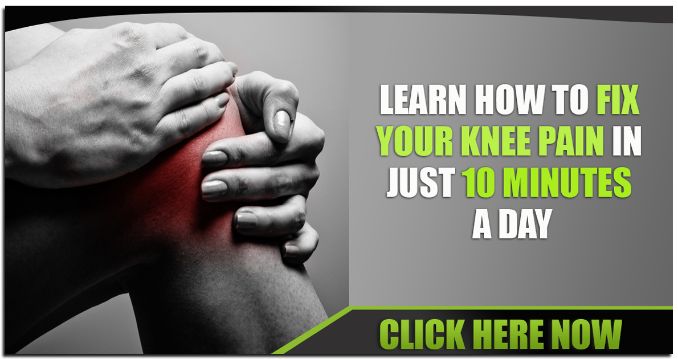Knee pain can hit anyone, whether you’re active, aging, or recovering from injury. If you’ve been battling discomfort while walking, bending, or simply trying to get through your day, the culprit might be tight or weak quadriceps muscles [1]
The good news? You don’t have to live with constant knee joint pain. Integrating simple quad stretches into your daily routine can improve flexibility, strengthen supporting leg muscles, and relieve pressure on the knees.
Before we dive into the benefits and deeper strategies, let’s go over the most effective quad stretches for knee pain [2]—step by step.
These low-impact exercises target not only your quadriceps, but also the surrounding thigh, hip, and gluteal muscles—helping reduce pain and improve your range of motion.
1. Standing Quad Stretch
Great for: Lengthening the front thigh muscles and reducing pressure on the knee joint.
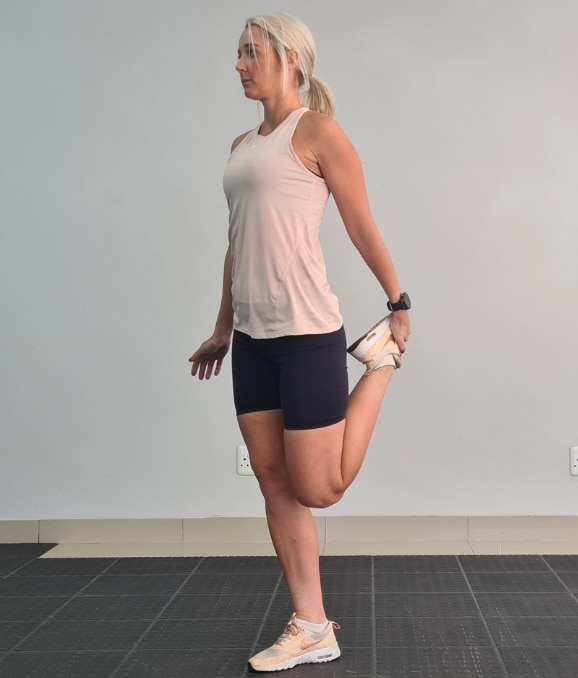
- Begin by standing tall on a flat surface or yoga mat, with your feet shoulder width apart and your posture upright.
- If needed, place one hand on a nearby wall or chair to help maintain balance.
- Shift your weight onto your right foot and bend your left knee, drawing your left foot up toward your buttocks.
- Reach back with your left hand and gently grasp your left ankle, keeping your thigh muscles in line and your knees close together.
- Maintain a tall posture with your chest lifted, hips squared forward, and shoulders relaxed.
- Be careful not to arch your back—your body should stay in a neutral, upright position.
- Hold this stretch for 20–30 seconds.
- Slowly lower your foot back to the floor and return to the starting position.
- Switch legs and repeat the movement on the opposite side.
Tip: Keep your core tight and your body in an upright position.
2. Bent-knee Stretch
Great for: People who need extra balance support.
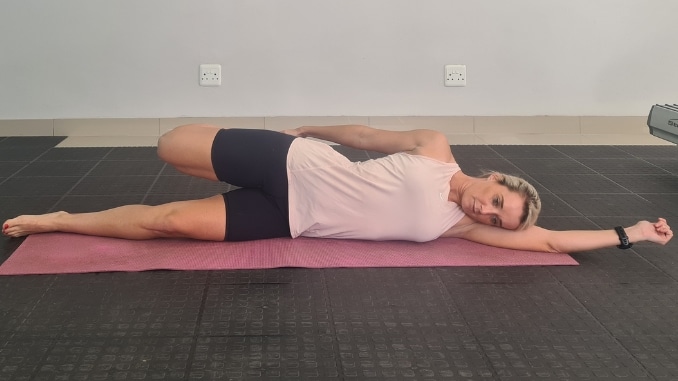
Lie down on your right side on a comfortable surface or yoga mat, with your body aligned—head, shoulders, hips, and legs stacked in a straight line. Rest your right arm under your head or extend it straight for support.
- Bend your left knee and reach back with your left hand to grab your left ankle or foot.
- Gently pull your heel toward your buttocks, feeling a deep stretch through your left thigh and hip muscles.
- Keep your hips stacked vertically and your core gently engaged to prevent rolling forward or backward.
- Your lower leg should remain straight, and your shoulders relaxed.
- Hold the stretch for 30 seconds.
- Slowly release your ankle, return to the starting position, and roll over to repeat the movement on the opposite side.
3. Quad and Hip Flexor Stretch
Great for: Deep quad and hip muscle release.
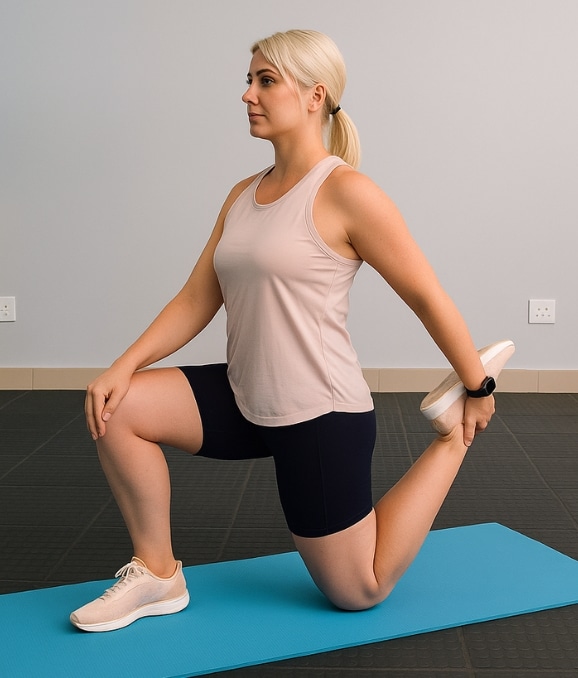
Begin by kneeling on your left knee on a yoga mat, placing your right foot flat on the floor in front of you, so your front knee is bent at a 90-degree angle—similar to a lunge position.
- Maintain a tall posture with your shoulders relaxed and hips squared forward.
- Carefully reach back with your left hand to grab your left ankle or foot.
- Slowly bend your back leg, pulling your heel gently toward your buttocks.
- If needed, place a yoga block or use a wall for balance support.
- As you hold your ankle, gently pull while keeping your torso upright and your core engaged.
- You should feel a strong but comfortable stretch through the front of your left thigh and hip flexors.
- Hold this position for 20 seconds, breathing slowly and deeply to relax into the stretch.
- Keep your gaze forward or slightly down to stay aligned.
- Release the ankle slowly, return to your starting position, and repeat the stretch on the opposite leg.
4. Wall-Assisted Quad Stretch (Low Impact)
Perfect for: Beginners or those recovering from injury.

Position yourself near a wall and kneel on your left knee, with your left shin and foot gently resting against the wall.
- Place your right foot flat on the floor in front of you, so the front knee is bent at a 90-degree angle.
- Use your hands to slowly raise your torso into an upright position, engaging your core and keeping your back straight.
- This may feel intense—move slowly and use support if needed.
- Once upright, gently press your hips forward.
- You should feel a deep stretch along the front of your left thigh, into the hip flexors and quadriceps muscles.
- Breathe slowly and hold this position for 20–30 seconds, focusing on maintaining your balance and posture.
- Keep your shoulders relaxed and avoid leaning too far forward or arching your back.
- To exit, slowly lower yourself, bring your front foot back, and switch sides to repeat the stretch with your right knee against the wall.
Quad Stretch Benefits
Here’s why these quad stretches [3] can transform your knee health:
- Eases knee pain by reducing tightness in the quadriceps and surrounding leg muscles.
- Improves joint mobility by increasing the range of motion in the knees and hips.
- Supports injury recovery, especially for the lower leg, hip flexors, and gluteal muscles.
- Enhances balance and posture during activities like walking or standing.
- Prevents overcompensation by strengthening one leg at a time, avoiding strain on the other leg.
Dr. Jordan Metzl, MD – Sports Medicine Physician at Hospital for Special Surgery (HSS), New York
“Quad flexibility plays a crucial role in maintaining healthy knee mechanics. When the quadriceps are tight, they pull on the patella (kneecap), increasing pressure in the joint and often leading to anterior knee pain. Regular stretching, especially after activity, can help reduce strain on the knee and prevent overuse injuries.”
Bonus: Strengthening Exercises to Pair with Quad Stretches
To really bulletproof your knees, add these simple moves:
- Leg raises (keep the leg straight and toes pointing up).
- Step-ups using a yoga block or chair (alternate one foot at a time).
- Hamstring stretch for balance between front and back thigh muscles.
- Calf stretch to ease tension down the lower leg chain.
All of these can be done with a resistance band or bodyweight, right from home.
When to See a Doctor for Knee Pain

While stretching can bring major relief, there are times you need professional help:
- If pain persists despite stretching and low impact exercises
- If your knee locks, gives out, or swells frequently
- Sharp pain behind the kneecap or along the side leg
- Difficulty putting weight on one foot or bending the knee
Consult a healthcare professional or physical therapist to rule out injuries like ligament tears or advanced joint damage.
Final Thoughts
Whether your pain is from sitting too long, overtraining, or aging, quad stretches for knee pain are a must-have tool in your wellness toolbox.
Incorporate them into your daily routine, stay consistent, and watch your knee discomfort ease, your mobility return, and your confidence grow. Stay flexible, stay strong—your knees will thank you.
If you are suffering from any kind of knee discomfort and want to eliminate knee soreness permanently, then click here to check out the Knee Pain Solved Program!
Frequently Asked Questions
Can quad stretches really help reduce knee pain?
Yes. Tight quadriceps muscles can pull on the knee joint and contribute to pain, especially around the kneecap. Stretching the quads helps release tension, improve alignment, and support pain relief by reducing pressure on the joint.
How often should I do quad stretches for knee pain relief?
Aim for at least 3–5 times per week, or even daily if you’re managing ongoing discomfort. Hold each stretch for 20–30 seconds and repeat 2–3 times per leg for the best results. Consistency is key for long-term improvement.
What if stretching my quads causes more pain in my knee?
Mild discomfort during a stretch is normal, but sharp or increasing pain is not. If stretching worsens your symptoms, stop immediately and consult a physical therapist or healthcare professional. You may be dealing with an underlying injury or imbalance.
Should I stretch before or after exercise for knee pain?
After exercise, deep quad stretches are best, as your muscles are warm and more pliable. However, a short dynamic warm-up that includes light leg movements or leg raises is helpful before physical activity to improve blood flow and prevent strain.

